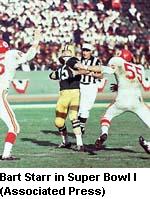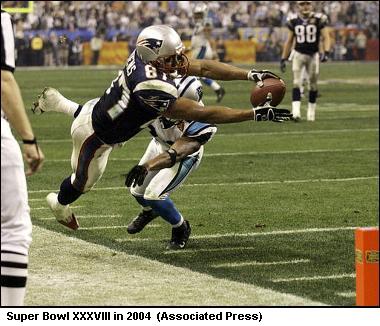TV Technology: 47 Ways To Watch A Football Game
By: Jason Arcuri
By looking at the way in which the production and presentation of the Super Bowl has evolved over the years, it should be apparent that television technology has had a distinct effect on the game's shift towards a more entertainment-oriented theme. Though some would attribute this effect solely to the fact that technology has simply become more advanced over the years (therefore, making TV more appealing and entertaining as a whole), it is important to examine how these innovations are being created and used in the game.
Disregarding the technology
of the time, the early Super Bowl games were produced as  just
that: a game. With a television broadcast team consisting of a few
dozen people and only a handful of standard stationary cameras,
the Super Bowl was presented in a way which intently focused on
the action that was occurring on the field. In fact, the only deviations
from the standard panoramic views of the game were set shots of
players and coaches on the sidelines and of the crowd in the stands.
Essentially, the reasoning behind this motive stemmed from the belief
that the game (and only the game itself) was the main attraction
to the viewer. However, as the Super Bowl began to grow in stature
and develop a wider, more diverse television audience (which included
"non-fans" of football), there became increased pressure
to ensure that the game could be enjoyed by all viewers alike.
just
that: a game. With a television broadcast team consisting of a few
dozen people and only a handful of standard stationary cameras,
the Super Bowl was presented in a way which intently focused on
the action that was occurring on the field. In fact, the only deviations
from the standard panoramic views of the game were set shots of
players and coaches on the sidelines and of the crowd in the stands.
Essentially, the reasoning behind this motive stemmed from the belief
that the game (and only the game itself) was the main attraction
to the viewer. However, as the Super Bowl began to grow in stature
and develop a wider, more diverse television audience (which included
"non-fans" of football), there became increased pressure
to ensure that the game could be enjoyed by all viewers alike.
In response to this shift
in ideology, it seems as though "at least on major technical
 innovation
in television coverage has become obligatory for each Super Bowl"
(Patton, 1984, p.117). With the
intent of enhancing the way in the which the viewer experiences
the football game, the Super Bowl has become the birthplace for
such TV innovations as instant replay, telestrators,
"Sky-Cams" and "Matrix
Cameras", many of which have gone on to become permanent
fixtures within the realm of sports broadcasting. More recently,
Super Bowl audiences have also benefited from the incorporation
of the internet into the game's TV broadcast, something which
(by allowing viewers to participate and vote on in-game polls and
the Most Valuable Player honors) has made the Super Bowl a distinctly
interactive TV experience.
innovation
in television coverage has become obligatory for each Super Bowl"
(Patton, 1984, p.117). With the
intent of enhancing the way in the which the viewer experiences
the football game, the Super Bowl has become the birthplace for
such TV innovations as instant replay, telestrators,
"Sky-Cams" and "Matrix
Cameras", many of which have gone on to become permanent
fixtures within the realm of sports broadcasting. More recently,
Super Bowl audiences have also benefited from the incorporation
of the internet into the game's TV broadcast, something which
(by allowing viewers to participate and vote on in-game polls and
the Most Valuable Player honors) has made the Super Bowl a distinctly
interactive TV experience.
While all of this unfolds
to the absolute delight of those who actually have an interest in
the game, these innovations also make the game much more appealing
to those with a more casual interest, the "non-fans".
For many observers, the reason for this is that the television technology
plays a significant role in enhancing the game's "entertainment
value", turning it into a show similar to the ones which are
broadcast on regular TV. In this case, the Super Bowl could be viewed
as not just another barbaric football game, but as another version
of prime-time TV entertainment.

|
Disclaimer © 2003 - 2004 by class of SOSC 4319 at York University |